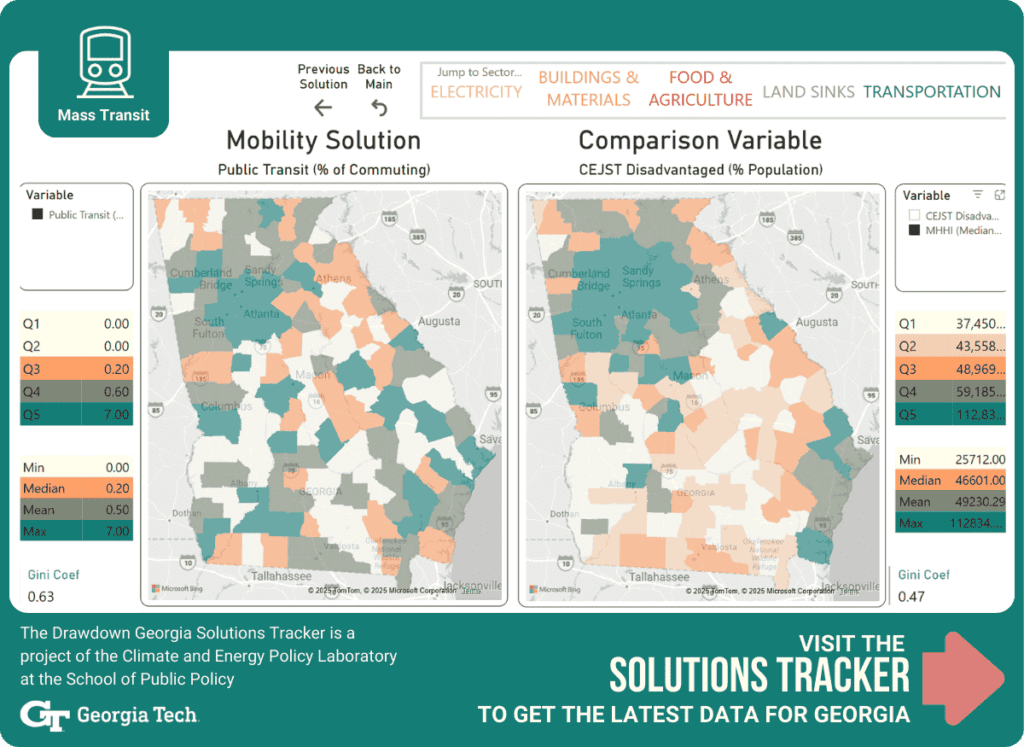The Benefits of Mass Transit
Public mass transit includes buses, trains, and streetcars. Relying on mass transit instead of cars reduces greenhouse gas emissions.
Access Mass Transit Resources from Drawdown Georgia
Market Readiness and Available Technology
The technology for mass transit options is readily available, and there are well-established markets for it in Georgia. Behavioral shifts, however, are required to achieve maximum carbon emissions reduction potential.
An increase in ride-hailing options like Lyft and Uber has slowed the uptake of public transit ridership. Increasing transit ridership can significantly reduce greenhouse gas emissions, driven by more advanced vehicle technology and routing intelligence.
Mass Transit as a Climate Solution in Georgia
The Drawdown Georgia research team estimates that Georgia could reduce emissions by one megaton (Mt) of CO2e by locating 320,000 additional households in transit-oriented developments.
What is the Carbon Emissions Reduction Potential by 2030?
Achievable reduction potential is derived by taking the technical reduction potential, outlined below, and developing a more realistic forecast that takes current rates of deployment, market constraints, and other barriers into consideration.
For mass transit, the Drawdown Georgia research team has calculated the achievable reduction potential to be 0.37 Mt of CO2e.
What Is the Upper Limit of Carbon Emissions Reduction Potential?
Technical reduction potential reflects the upper limit of emissions reductions for this solution without regard to the constraints that exist in the real world, such as economic or political considerations.
For mass transit, the Drawdown Georgia research team has calculated the technical reduction potential to be 1.1 Mt.
Progress on Mass Transit in Georgia
MARTA has plans to improve the bus service by various means in the four jurisdictions it serves: the City of Atlanta, Clayton County, DeKalb County, and Fulton County. There are currently no plans to extend the light rail systems, and votes to extend the service into Gwinnett County failed in 2019 and 2020.

According to MARTA, the plans to expand in the immediate future include arterial and bus rapid transit, dedicated bus lanes, and traffic signals that give buses priority. MARTA also had a pilot program for On-Demand Multi Modal Transit System in 2022 called MARTA Reach, which connected users’ start/end points to transit stations via a shuttle bus that was hailed through an app. MARTA has announced that they will partner with the City of Atlanta to build four new rail stations on pre-existing tracks, with no timetable publicly available.
Votes to implement a 1% sales tax to fund the expansion of bus services in Cobb and Gwinnett counties failed to gain a majority of voter support in 2024. There are also smaller transit authorities, like the CobbLinc and Ride Gwinnett, and most counties have an on-demand shuttle service for certain destinations.
How Reliable Is Our Estimate For This Drawdown Georgia Climate Solution?
Georgia has MARTA, GRTA, Ride Gwinnett, and CobbLinc in the Atlanta metro area; Macon-Bibb County Transit Authority; Athens Transit; and Chatham Area Transit in Savannah. As a result, significant data is available on ridership demand and vehicle and system efficiency. While large deployments of electric vehicles have not been undertaken in Atlanta, a growing dataset is available from other urban transit systems, which is relatively translatable.
For a rough order of magnitude comparison, it is estimated that mass transit options in Georgia (MARTA in Atlanta in particular) release .245 lbs CO2/passenger mile, compared to .891 lbs CO2/passenger mile for a single occupancy vehicle personal vehicle. While a true trip comparison and consideration of ridership would be required to complete the analysis, this suggests that carbon emission reduction potential is technologically achievable. This figure decreases further as ridership percentages rise since the system increases in efficiency.
Significantly reduced carbon emissions for most trips is possible so long as ridership is sufficiently high. Beyond directly replacing existing trips, the availability of transit alters land use patterns that result in fewer or shorter vehicular trips, which in turn helps to reduce tailpipe emissions. In reviewing the literature, one comprehensive study found that carbon emission reductions can be on the order of 70% lower than diesel emissions for EV bus applications in a simulation of European and California contexts.
Cost Competitiveness
Government subsidies for transit can reduce the cost per trip. For passengers, mass transit can frequently be the cheapest mode of travel (and the lowest CO2 option), replacing the financing, operating, and maintenance costs associated with owning personal vehicles with a small fare or a monthly pass.
While this option may incur longer commutes, direct cost savings can be considerable. In a given benefit-cost comparison, an EV bus was found to have a capital cost of 2 to 3x that of a diesel bus in an identical application but a net operating cost of less than 1.5x due to reduced energy, maintenance, and operating expenses. Finally, the EV-Diesel transit bus cost gap is expected to approach parity by about 2030.
Beyond Carbon Attributes
Benefits include improved air quality from a reduction in higher emission passenger vehicles, potential for increased business and property values in areas around mass transit stations, improved quality of life and reduced obesity, and reduced vehicle traffic and congestion in cities. Potential equity benefits include low-cost access to transportation in low-income communities and for those who cannot drive or do not have a driver’s license.
In terms of potential adverse impacts, expanding transit can negatively impact land and neighborhoods. Other concerns include the potential for an increase in crime-related activities in neighborhoods around stations.



